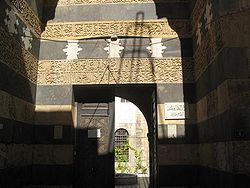

|
No edit summary
|
+2011 info
|
||
| Line 33: | Line 33: | ||
}} |
}} |
||
The '''Az-Zahiriyah library''' ({{lang-ar|المكتبة الظاهرية}}) in [[Damascus, Syria]] dates back to 1277, taking its name from its founder [[Sultan]] [[Baibars]] (1223–1277). Building this library was his father’s idea but he died before he could achieve it. Initially Az-Zahiriah was a public school in charge of teaching [[Quranic]] sciences. The decorations, carvings, and writing on the building walls, in addition to the gate which bears geometric designs and patterns, make the library one of the most important buildings in Damascus. |
The '''Az-Zahiriyah library''' ({{lang-ar|المكتبة الظاهرية}}) in [[Damascus, Syria]] dates back to 1277, taking its name from its founder [[Sultan]] [[Baibars]] (1223–1277). Building this library was his father’s idea but he died before he could achieve it. Initially Az-Zahiriah was a public school in charge of teaching [[Quranic]] sciences. The decorations, carvings, and writing on the building walls, in addition to the gate which bears geometric designs and patterns, make the library one of the most important buildings in Damascus. It is located at Bab el Barid in the [[Al-Amara]] neighborhood.<ref name="Gruyter-2011" /> |
||
The mosaics of the [[Umayyad Mosque]] gave inspiration to the decoration of the main prayer hall where a band of lavish golden floral and architectural mosaics is running around.<ref>[http://www.archnet.org/library/sites/one-site.jsp?site_id=2777 Zahiriyya Madrasa and Mausoleum of Sultan al-Zahir Baybars<!-- Bot generated title -->]</ref> |
The mosaics of the [[Umayyad Mosque]] gave inspiration to the decoration of the main prayer hall where a band of lavish golden floral and architectural mosaics is running around.<ref>[http://www.archnet.org/library/sites/one-site.jsp?site_id=2777 Zahiriyya Madrasa and Mausoleum of Sultan al-Zahir Baybars<!-- Bot generated title -->]</ref> |
||
| Line 42: | Line 42: | ||
Sultan Al-Zahir Baibars, also known as Rukn Uddin Baybrus (full name, al-Malik al-Zahir Rukn al-Din Baibars al-Bunduqdari) was buried in Damascus in 1277 under the dome of the Az-Zahiriyah library, established by him. |
Sultan Al-Zahir Baibars, also known as Rukn Uddin Baybrus (full name, al-Malik al-Zahir Rukn al-Din Baibars al-Bunduqdari) was buried in Damascus in 1277 under the dome of the Az-Zahiriyah library, established by him. |
||
As of 2011, the library's holdings included some 100,000 volumes, 13,000 manuscripts, and 50,000 periodicals.<ref name="Gruyter-2011">{{Citation |publisher = De Gruyter Saur |title = World Guide to Libraries |publication-date =2011 |edition =25th }}</ref> |
|||
==See also== |
==See also== |
||
| Al-Zahiriyah Library المكتبة الظاهرية | |
|---|---|

Entrance to Al-Zahiriyah Library
| |
| Location | |
 | |
| Coordinates | 33°30′44.5″N 36°18′18.5″E / 33.512361°N 36.305139°E / 33.512361; 36.305139 |
| Information | |
| Type | Public library, Madrassah |
| Established | 1277 |
| Founder | Sultan Baibars |
| Affiliation | Islamic |
The Az-Zahiriyah library (Arabic: المكتبة الظاهرية) in Damascus, Syria dates back to 1277, taking its name from its founder Sultan Baibars (1223–1277). Building this library was his father’s idea but he died before he could achieve it. Initially Az-Zahiriah was a public school in charge of teaching Quranic sciences. The decorations, carvings, and writing on the building walls, in addition to the gate which bears geometric designs and patterns, make the library one of the most important buildings in Damascus. It is located at Bab el Barid in the Al-Amara neighborhood.[1]
The mosaics of the Umayyad Mosque gave inspiration to the decoration of the main prayer hall where a band of lavish golden floral and architectural mosaics is running around.[2]
The manuscript department includes over 13,000 classical Islamic manuscripts, the oldest being Imam Ahmad ibn Hanbal’s Kitab al-zuhd and Kitab al-fada'il. Other notable manuscripits include Ta'rikh DimashqbyIbn 'Asakir (1105–1175), al-Jam bayn al-gharibayn by Abu `Ubaydah Ahmad ibn Muhammad Al-Harawi (d. 1010), and Gharib al-hadithbyIbn Qutaybah al-Dinawari (d. 889).[3]
The library was nationally recognized by the Syrian state in 1880. In 1919 the "Arab Academy was charged with the supervision of the al-Zahiriyya Library. … Its collection consisted at that time of the surviving manuscripts from different small libraries in Syria. … The collection grew from 2,465 manuscripts to 22,000 volumes between 1919 and 1945."[4] In 1949 a legal deposit law decreed that two copies of every work published in Syria be deposited in the library. The law was not enforced until July 1983, when a presidential decree required the deposit of 5 copies of each work published by a Syrian author. In 1984 the Al-Assad Library became the Syrian national library, replacing al-Zahiriyah Library.
Sultan Al-Zahir Baibars, also known as Rukn Uddin Baybrus (full name, al-Malik al-Zahir Rukn al-Din Baibars al-Bunduqdari) was buried in Damascus in 1277 under the dome of the Az-Zahiriyah library, established by him.
As of 2011, the library's holdings included some 100,000 volumes, 13,000 manuscripts, and 50,000 periodicals.[1]